Exhibition dates: 4th May, 2022 – 2nd April, 2023
Terminal 2, Departures Level 2, Gallery 2A
Dominick & Haff (American, New York) (manufacturer)
Footed dish
1880
Sterling silver, mixed metal
Private Collection
Dominick & Haff, based in New York City, produced some of the most magnificent silver objects during the late nineteenth century. The “outer” layer of this footed dish displays hexagonal hammering that appears torn away to reveal differing patterns beneath. Multi-coloured gold butterflies and foliage accent the piece.
A change of pace… time for things exquisite!
Dr Marcus Bunyan
Many thankx to the SFO Museum for allowing me to publish the photographs in the posting. Please click on the photographs for a larger version of the image.
Royal Doulton (Burslem, Staffordshire, England) (manufacturer)
Plate, “Spray” pattern border
c. 1896
Earthenware with transfer print, glaze, gilding
Courtesy of Jeffrey Ruda
Royal Doulton (Burslem, Staffordshire, England) (manufacturer)
Moon flask, “Spray” pattern
c. 1880
Earthenware with transfer print, glaze, gilding
Courtesy of Jeffrey Ruda
This plate features hanging wisteria. A symbol of longevity (fuji, 藤), wisteria has been grown for thousands of years in Japan. The motif often appears on kimono and many forms of Japanese art. Royal Doulton, which was founded in 1815, produced this “Spray” pattern in the 1880s, likely inspired by Japanese mon (紋). Mon are decorative crests traditionally used to identify a Japanese family.
Gorham Manufacturing Company (American, Providence, Rhode Island) (manufacturer)
Set of fruit knives
c. 1875
Sterling silver, bronze, gilding
Private Collection
Small utility knives, known as kozuka (小柄), had long been highly valued craft objects in Japan where they were traditionally cast from fine metals, such as bronze. After Japan opened to international trade, craftsmen produced kozuka for Westerners who sometimes repurposed the handles to make dining knives. Eventually Japanese manufacturers began selling the handles alone, crafting them from various metals with die stamped decoration gilded in select areas. The Gorham Manufacturing Company added their own sterling silver blade designs, decorated with butterflies, fans, and geometric patterns applied to Western-style utensils, such as dessert forks and salad servers. The resulting knives resemble Japanese swords with decorated handles.
[left to right]
Josiah Wedgwood & Sons (Etruria, Staffordshire, England) (manufacturer)
Plate depicting an actor
c. 1875
Earthenware with transfer print and enamels
Courtesy of Jeffrey Ruda
Josiah Wedgwood & Sons (Etruria, Staffordshire, England) (manufacturer)
Plate depicting an actor
c. 1875
Earthenware with transfer print and enamels
Courtesy of Jeffrey Ruda
Josiah Wedgwood & Sons (Etruria, Staffordshire, England) (manufacturer)
Plate depicting a musician, “Mikado” border pattern
c. 1875
Earthenware with transfer print and enamels
Courtesy of Jeffrey Ruda
Josiah Wedgwood & Sons
Established in the eighteenth century, Josiah Wedgwood & Sons embraced Japonisme during the late nineteenth century when English transfer-printed earthenware with complex, inventive Japanese-inspired patterns reached an apex.
[center plate]
The young man with a sword and the landscape backdrop on this plate are broadly adapted from Japanese woodblock prints of actors. A few details suggest that Wedgwood’s artist studied Japanese prints: the placement of the feet and the bend of a wrist. However, the clothing and the landscape structure are so unlike Japanese styles, they prove they were not copied from a Japanese source.
Unknown manufacturer (English)
Dinner gong with sparrow
c. 1885
brass, copper
Courtesy of Brian D. Coleman
This dinner gong exhibits faux bamboo supports and a sparrow in flight, highlighting the European maker’s interpretation of Japan’s admiration for the natural world and its influence on Western art.
French author Philippe Burty (1830-1890) coined the term Japonisme in 1872 to describe the new fervor for all things Japanese, following Japan’s opening to international trade after a prolonged period of isolation from the West. The increased visibility of Japanese art and design overseas profoundly affected European and North American audiences as ceramics, ukiyo-e woodblock prints, metalwork, lacquerware, fans, and textiles flooded Western markets. Japonisme permeated fine and decorative arts, interior design, and graphic arts. Artists such as Vincent van Gogh (1853-1890) and James Abbott McNeill Whistler (1834-1903) were deeply inspired by Japanese art. American silver manufacturers including Tiffany & Company and the Gorham Manufacturing Company were determined to create metalwork as fine as Japan’s. English potteries took heed of Japanese designs to create a plethora of new patterns.
The first world’s fair to feature Japanese art took place in London in 1862. Japan’s official participation in an international exposition occurred in Paris in 1867, followed by Vienna in 1873, and Philadelphia in 1876. These expositions exposed millions of people to Japanese art, craft, design, and architecture. Japanese art dealers, such as Hiromichi Shugio (1853-1927) in New York, Bunkio Matsuki (1867-1940) in Boston, and Tadamasa Hayashi (1853-1906) in Paris, helped introduce Japanese arts to American and European clienteles. Prominent English designer Christopher Dresser (1834-1904) travelled to Japan in 1876, later publishing his influential book Japan: Its Architecture, Art, and Art Manufacturers (1882). Art critics and home journals of the era regularly published articles addressing how to decorate one’s home in a Japanese-inspired style. Collectors eagerly purchased authentic Japanese goods and Western interpretations of them.
Western decorative arts manufacturers adopted Japanese motifs, such as asymmetry and imagery inspired by the natural world, including insects – from butterflies and dragonflies to black flies. The spider and its web now adorned everything from silver plate to wallpaper and framed portraits. Birds and sea creatures, such as cranes, owls, and carp were introduced as decorative motifs. Western artists looked at familiar trees and changing foliage in a new light – from cherry blossoms to autumn maple leaves, and bamboo. A variety of flowers found new meaning, including peonies, wisteria, and irises. The intriguing decorative lexicon of Japan also included ocean waves, clouds, lightning bolts, and cracked ice.
This exhibition features American and European decorative arts from the 1870s-1890s, when Japonisme reached its peak in popularity. Rather than directly copying, Western artists drew freely from Japanese ornament reinterpreting objects ranging from sterling silver flatware and holloware to colourful ceramic plates and vessels. Designs on Japanesque lamps, fire screens, and book covers are among the many everyday items that also feature imaginative imagery, all of which reflect an early and remarkable example of international cultural exchange between Japan and the West.
Text from the SFO Museum website
Dominick & Haff (American, New York) (manufacturer)
Sugar bowl
1884
Sterling silver
Private Collection
William B. Durgin Company (American, Concord, New Hampshire) (manufacturer)
Pitcher
c. 1885
Sterling silver
Private Collection
A dragonfly appears on this sugar bowl. This common Japanese decorative motif was eagerly absorbed by the West during the height of Japonisme and by the Art Nouveau movement that followed it. This unusually shaped pitcher, with chased decoration wrapping around all three sides, has a handle shaped like a segmented stalk of bamboo.
Gildea & Walker (Burslem, Stoke-on-Trent, England) (manufacturer)
Serving platter, “Melbourne” pattern
1881-1885
Earthenware with transfer print and enamels
Courtesy of Jeffrey Ruda
Christopher Dresser (English, 1834-1904) (designer)
Old Hall Earthenware Company (Stoke-on-Trent, Staffordshire, England) (manufacturer)
Pitcher
c. 1881
Earthenware with transfer print and enamels
Courtesy of Brian D. Coleman
The pattern Gildea & Walker marketed under the trade name of “Melbourne” was one of the most popular transfer-printed designs in the Japanesque style and was offered in several colours. The eclectic, asymmetrical pattern incorporates a seascape, horizon line, sparrows, bamboo, blossoms, and an owl in the moonlight.
English designer Christopher Dresser (1834-1904) traveled extensively throughout Japan in 1876-1877 as a guest of the Japanese government. He was accompanied by translators, guides, sketch artists, and photographers. Dresser visited Buddhist temples, Shinto shrines, and historic sites. He met artists and craftspeople at dozens of potteries and workshops focusing on metalwork, basketry, and lacquer. Upon returning, he published Japan: Its Architecture, Art, and Art Manufacturers (1882), one of the first wide-ranging Western publications on Japanese arts and architecture.
[Left to right]
Gorham Manufacturing Company (American, Providence, Rhode Island) (manufacturer)
Cigar lighter
1881
Mixed metal
Private Collection
Gorham Manufacturing Company (American, Providence, Rhode Island) (manufacturer)
Coffee pot
c. 1883
Copper, silver
Private Collection
Gorham Manufacturing Company (American, Providence, Rhode Island) (manufacturer)
Tea caddy
1881
Copper, silver
Private Collection
The Gorham Manufacturing Company excelled in crafting Japanese-inspired objects of copper with silver appliqués that were hand hammered by their artisans. The small, patinated copper lighter exhibited here has a dragon handle; a spider appears on one side, while a Japanese woman and crane appear on the other side.
The Gorham Manufacturing Company began as a small silversmithing company in 1831, later becoming New England’s premier artistic silver manufacturer. John Gorham (1820-1898) and his chief designer George Wilkinson (1819-1894), who traveled to Japan in 1880, rivalled Tiffany & Company in their successful adoption of Japanese principles in the development of a wide range of wares. This eclectic Turkish-style coffee pot exhibits applied silver floral decoration on its front and a dragonfly on back.
Two flies are perched upon this tea caddy. Like the spider-and-web motif, Western artists had never thought to use flies as applied ornament before exploring Japanese art.
[Clockwise]
Christopher Dresser (English, 1834-1904) (designer, attributed to)
Minton’s China Works/Minton & Company (Stoke-on-Trent, Staffordshire, England) (manufacturer)
Tile
c. 1870-1880
Earthenware with block printing
Courtesy of Jeffrey Ruda
Pierre Mallet (French, 1836-1898, active in England c. 1870) (designer)
Brown-Westhead, Moore & Co. (Cauldon Place, Hanley, Staffordshire, England) (manufacturer)
Tile
c. 1880
Earthenware with transfer-printed etching and enamels
Courtesy of Jeffrey Ruda
Sherwin & Cotton (Hanley, Staffordshire, England) (manufacturer)
Tile, “Cracked Ice” pattern
c. 1880
Earthenware with transfer prints and enamels
Courtesy of Jeffrey Ruda
This first tile shows three cranes flying above waves, with a full moon and two clouds behind them. The cranes and waves are adapted from a Japanese pot that was displayed as a “jardinière” at the International Exhibition in London in 1862. The Minton Archive holds a drawing signed by Christopher Dresser that shifts the motif on the pot to a horizontal format with three cranes flying over stylised waves, along with a cloud and full moon.
Whiting Manufacturing Company (American, New York) (manufacturer)
Seafood salad bowl, “Fish-net” pattern
1885
Sterling silver
Private Collection
Tiffany & Company (American, New York) (manufacturer)
Ice bowl
c. 1877
Sterling silver
Private Collection
The exterior of this seafood salad bowl is decorated with three different applied decorations in the form of a stylised carp caught in a net. In Japan, the carp (koi, 鯉) symbolises courage, strength, and fertility.
Tiffany & Company was America’s most distinguished artistic goods manufacturer and one of the first to adopt Japanese-influenced decoration, which was lauded as far as Europe and Japan. The company began importing Japanese works under the guidance of designer Edward C. Moore (1827-1891). Moore amassed a large collection of Japanese art, including ceramics, textiles, and metalwork that was later bequeathed to the Metropolitan Museum of Art. He also established Tiffany’s study collection and library. Most likely, Moore commissioned Christopher Dresser (1834-1904) to assemble a collection of objects during his tour of Japan in 1876-1877.
Arabella B. Buckley (British, 1840-1929) (author)
D. Appleton and Company (American, New York) (publisher)
Life and Her Children
1893
Collection of Catherine A. Ferron and Paul T. Roberts
Unknown manufacturer (American)
Photo album
c. 1880s
Paper, ink, gilding
Anonymous lender
Thomas W. Knox (American, 1835-1896) (author)
Harper & Brothers Publishers (American, New York) (publisher)
The Boy Travellers: Japan and China
1880
Collection of Catherine A. Ferron and Paul T. Roberts
Unknown manufacturer (English)
Hand-painted fire screen
c. 1880
glass, metal, paint
Courtesy of Brian D. Coleman
During the 1870s, stores specialising in Japanese art and merchandise, commonly referred to as Japanese novelty stores or fancy goods stores, opened across the United States – from New York and Boston to Philadelphia, Houston, and San Francisco. Many of the stores were owned by Japanese entrepreneurs. Art historian and print collector Hiromichi Shugio (1853-1927), was born into a privileged family in Saga Prefecture. He arrived in New York around 1880 and became the proprietor of First Japan Manufacturing and Trading Company in New York. Shugio curated the first major American exhibition of ukiyo-e prints at the Grolier Club in New York City in 1889. Bunkio Matsuki (1867-1940) came to San Francisco in 1888, soon moving to Salem, Massachusetts, where he established a Japanese section in the city’s leading department store, Almy, Bigelow & Washburn, stocking more than twenty-thousand items. Matsuki also opened a store in Boston and supplied works of art to the Museum of Fine Arts, Boston. Tadamasa Hayashi (1853-1906) learned French in his native country of Japan before travelling to Paris in 1878 to serve as a translator at the Exposition Universelle. Hayashi decided to remain in Paris and became a highly regarded art dealer, selling ukiyo-e and other artworks to an international clientele.
Royal Worcester (Stoke-on-Trent, Staffordshire, England) (manufacturer)
Dragon vase
c. 1880s
Earthenware, glaze
Courtesy of Brian D. Coleman
SFO Museum
San Francisco International Airport
P.O. Box 8097
San Francisco, CA 94128 USA
Phone: 650.821.6700

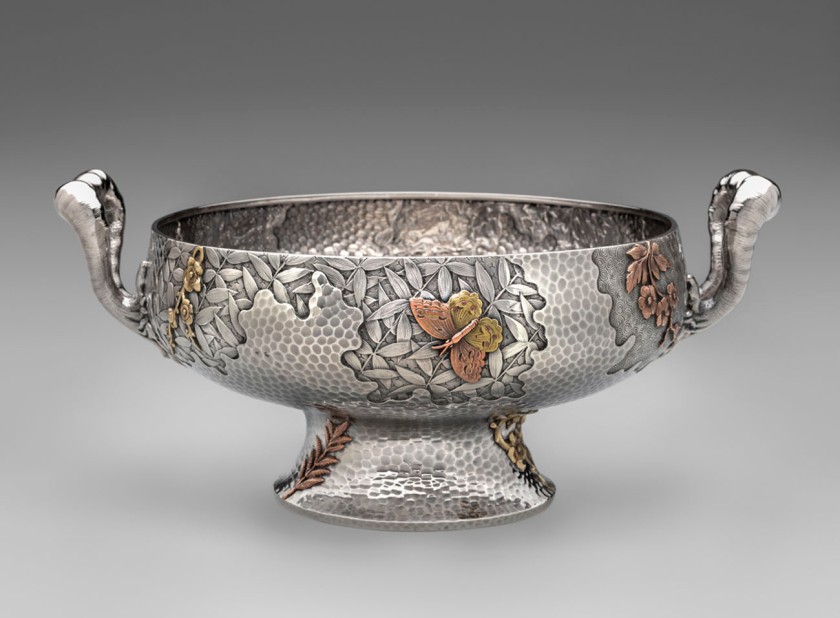
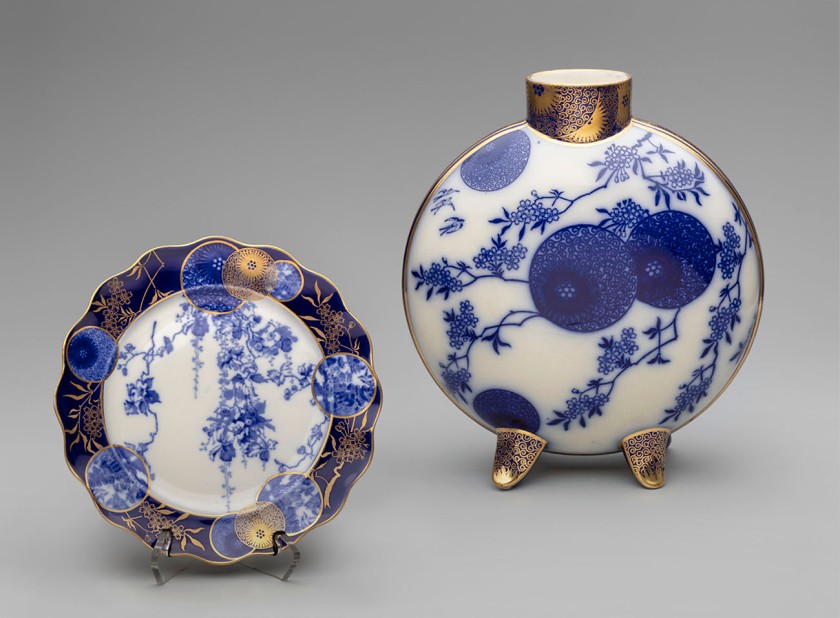
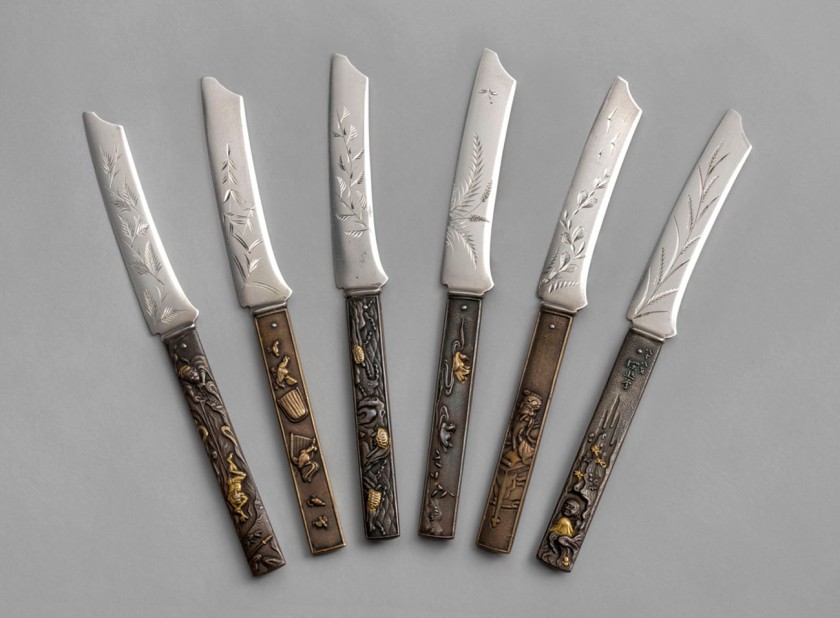
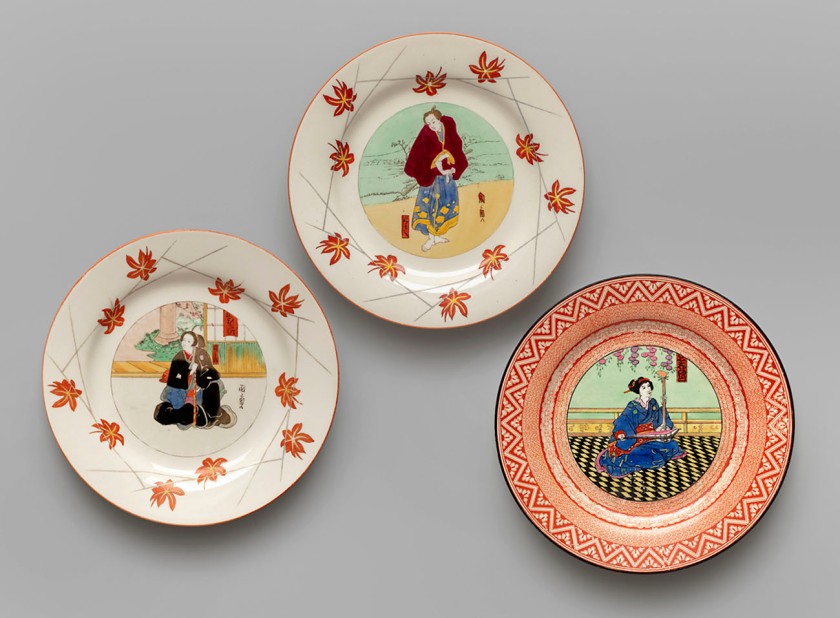

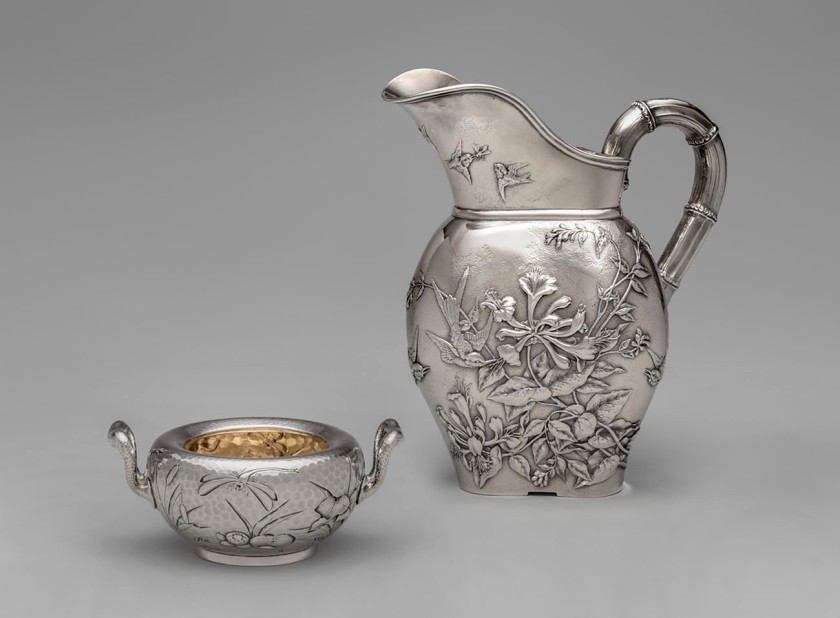

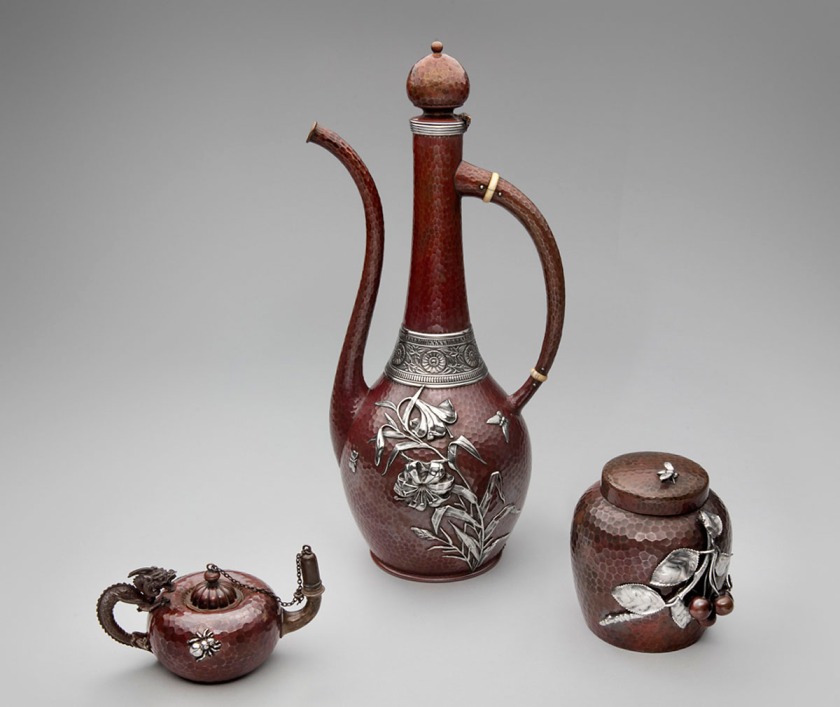
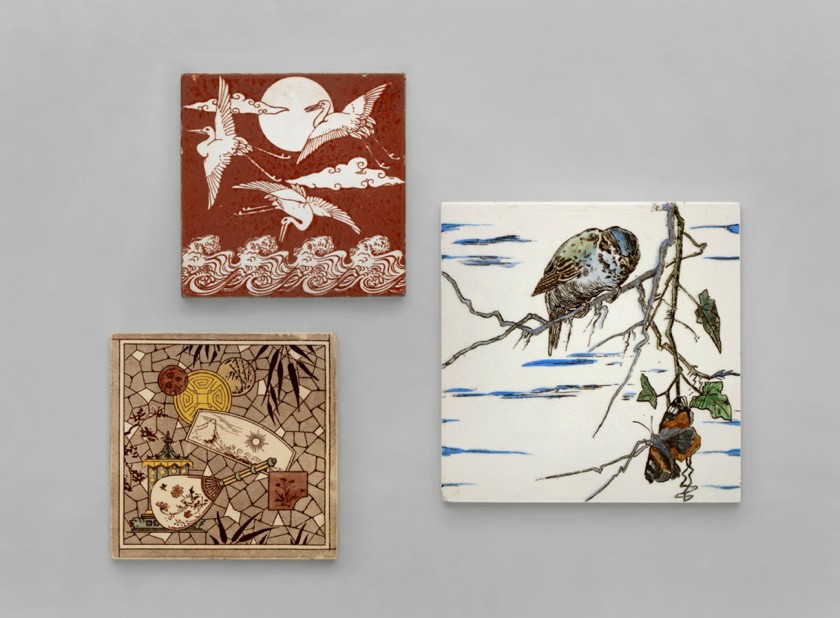
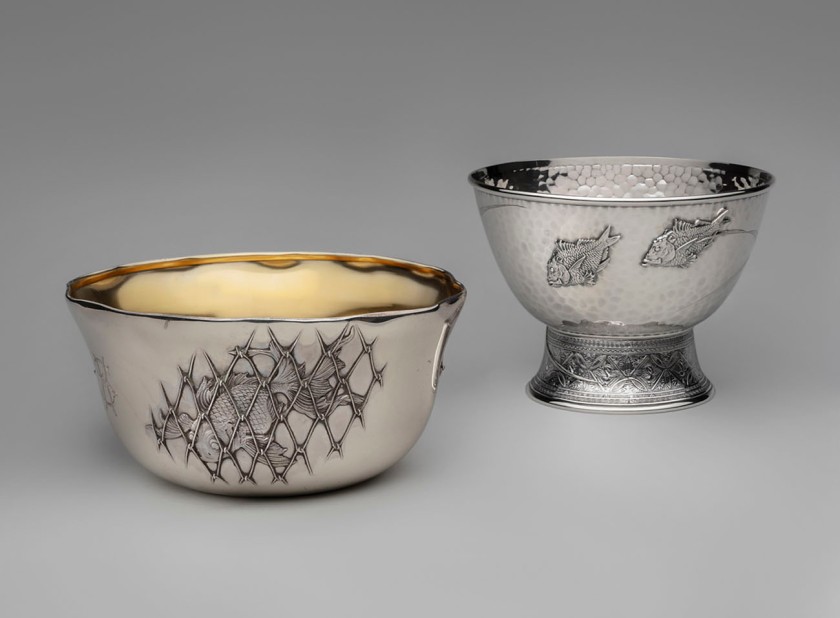
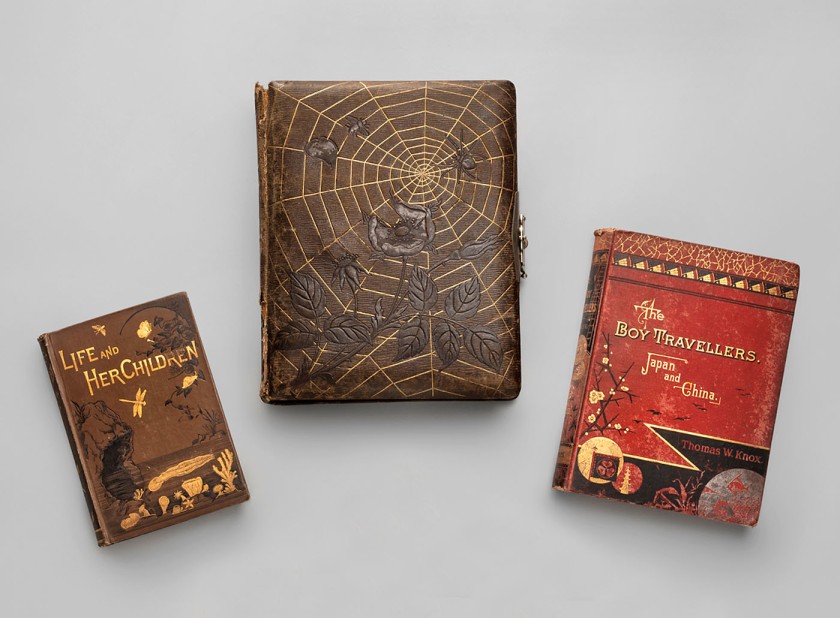


You must be logged in to post a comment.